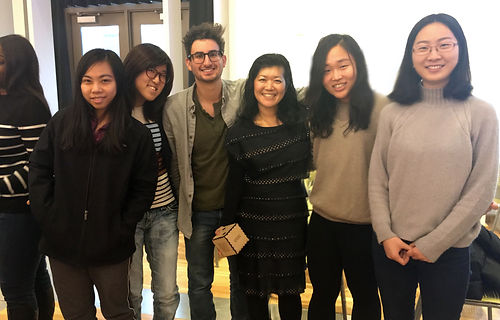
Ceremony
"How can we effectively measure emotions
in repeated group social interactions?"
As part of UXDC Design Clinic, I, along with four other designers, were tasked to design the mobile app Ceremony for our client Tom Meloche, co-founder of Menlo Innovations.
Tom is currently writing the book Ceremony which he hopes will improve productivity in the workplace by comparing meetings to ceremonial forms. He will be consulting companies on his book and wanted to also build a companion app to help companies implement the book's teachings. He contracted our team to create an interactive prototype to hand off to his developer. The app is expected in the Apple and Android app stores this Spring. The goal of the app is to empower employees to rate the success of reoccurring meetings (ceremonies) at work. The app then provides data on organization's meetings that will help them improve their productivity.
The design manager of our team took a parallel prototyping approach for the design process; hence, all of us were involved from every step of the design synthesis for this project. Personally, most valuable lesson from this design consulting experience is learning how to resolve differences in client's view and users' findings.
THE DESIGN PROCESS
1. From the Client

At the first client meeting, Tom had given us a great pitch on his idea, Ceremony, and the reasoning behind the app. As an agile coach, marketing expert, and founder, he had vast experiences in meetings and productivities in the workplace and hence wanted to build something that he thought could greatly enhance the value of iterative improvements in a workplace‘s ceremony.
It is clear that he had great vision and passion for this project in that he provided us much more than just an idea: he included envisioned features, wireframes, storyboards...etc. While our team could taken his materials and directly started hi-fi prototyping, we found a lack of users' voice/research from the materials Tom provided. Hence, our team decided to still start from the beginning.
2. User Research Personas + Affinity Wall

User Interview
We interviewed 8 different people and asked them questions about the meetings they attend. We talked to people who work in a wide range of industries including academic, religious, financial, construction, co-op housing, consulting, and technology.
Personas


We learned about the different types of meetings people attend regularly and the reasons they think meetings are successful or unsuccessful. From the insights of our interviews, we then created personas of a meeting's host and participant.
Affinity Wall
We decided to also perform affinity wall process of our interview findings to pinpoint big categories of how people value effective meetings. We found that regardless of industry of form, the following 5 top attributes that are essential for effective ceremonies:

-
Participant engagement in the meeting is key
-
People should feel encouraged to contribute
-
Good leadership matters
-
Good meeting structure increases productivity
-
Positive group culture helps ceremonies evolve
3. Parallel & Iterate Designing the Solution
System Site Map
We took a parallel prototyping approach to our design. All five designers worked on the designs of a feature of the app, and then we re-group to provide feedback, and iterate. It was a very new experience for me personally to experience such working process. We used this technique throughout the entire design process and created a system map, wireframes, lo-fi, and hi-fi mockups with interactions.
From our affinity wall, we realized the importance of separating roles (i.e. hosts v.s. participants) and how they may use this app differently. However, we wanted to keep one interface for all roles. Hence, we outlined the different ways a user will interact with the app based on their role using a system map. This helped us create our product requirements.

Wireframing
Once we have our product requirements, we started to dig deeper into interactions. In this process we focused on designing for a seamless experience -- wether a user needed to host a meeting or provide a feedback -- we want it to be as simple as possible. A user journey will consist of four things on the app: set up a ceremony, receive notifications after a ceremony ends, provide anonymous feedback, and then analyze ceremony data.

Lo-Fi Mockups
Again, with parallel prototyping, we all attempted lo-fi prototyping from the wireframe we agreed on. With different versions created, we then got together and critic each other's lo-fi designs, iterate, and finally combine to pick and choose the best ones to create the final prototype.


4. The Design Solution
With many iterations and design decisions, our team together created the final solution for our client. We made the screens that the client requested but also included extra screens that were essential from user findings. For instance, providing attributes to why a certain ceremony went badly was added to adhere app to user findings and provide incentives.
Below are mockups representing the main user journey for Ceremony.
User Journey:
-
Set Up a Ceremony
-
Receive Notifications After a Ceremony End
-
Provide Anonymous Feedback
-
Insights Reports
1. Set Up a Ceremony


2+3. Receive Notifications + Provide Anonymous Feedback

4. Insights Reports

6. Final Client Pitch + Team Photo
MY ROLE
UX Designer
WHAT I DID
-
Ideation
-
User Research
-
Wireframing
-
Low-fi Mockups
-
High-fi Prototype
TEAM
Justin Cohen
Jie-Wei Wu
Paris Hsu
Shu Zhou
Diana Oum
2016

The final pitch was very successful! Our client was very glad our team ended up still doing the user research and created something (even though slightly different than his original sketches) that could carry weight and adhere to user needs. It was a great learning experience for my personal communications skills: working with four other designs and trying to reaching consensus as well as managing client interactions.